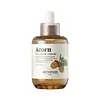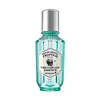What's inside
What's inside
 Key Ingredients
Key Ingredients

 Benefits
Benefits

 Concerns
Concerns

 Ingredients Side-by-side
Ingredients Side-by-side

Water
Skin ConditioningQuercus Acutissima Fruit Extract 10%
AstringentPropanediol
SolventDipropylene Glycol
HumectantButylene Glycol
HumectantGlycerin
HumectantNiacinamide
SmoothingPentylene Glycol
Skin ConditioningHamamelis Virginiana Extract
AntiseborrhoeicPolyglyceryl-10 Laurate
Skin ConditioningHydroxyacetophenone
Antioxidant1,2-Hexanediol
Skin ConditioningOpuntia Ficus-Indica Stem Extract
Skin ConditioningAcrylates/C10-30 Alkyl Acrylate Crosspolymer
Emulsion StabilisingTromethamine
BufferingDiospyros Kaki Fruit Extract
Skin ConditioningCamellia Sinensis Leaf Extract
AntimicrobialCastanea Crenata Shell Extract
Skin ConditioningGluconolactone
Skin ConditioningPanthenol
Skin ConditioningAllantoin
Skin ConditioningCarbomer
Emulsion StabilisingAdenosine
Skin ConditioningDiphenyl Dimethicone
EmollientTriethylhexanoin
MaskingSodium Phytate
Sodium Polyacryloyldimethyl Taurate
Emulsion StabilisingEnantia Chlorantha Bark Extract
Skin ConditioningSodium Hyaluronate
HumectantHydrolyzed Lupine Protein
Skin ConditioningDextrin
AbsorbentTheobroma Cacao Extract
Skin ConditioningPolyglyceryl-10 Oleate
Skin ConditioningHydrogenated Lecithin
EmulsifyingEucalyptus Globulus Leaf Oil
PerfumingRosmarinus Officinalis Leaf Oil
MaskingAmyris Balsamifera Bark Oil
MaskingBiosaccharide Gum-1
HumectantSalvia Officinalis Oil
MaskingCitrus Aurantium Bergamia Fruit Oil
MaskingPueraria Lobata Root Extract
HumectantUlmus Davidiana Root Extract
Skin ConditioningOenothera Biennis Flower/Leaf/Stem Extract
Skin ConditioningPinus Palustris Leaf Extract
TonicHelianthus Annuus Seed Oil
EmollientPalmitoyl Tripeptide-5
Skin ConditioningSalvia Sclarea Oil
MaskingEthylhexylglycerin
Skin ConditioningHydroxypropyltrimonium Hyaluronate
Oleanolic Acid
Skin ConditioningSodium Acetylated Hyaluronate
HumectantHydrolyzed Hyaluronic Acid
HumectantHyaluronic Acid
HumectantSodium Hyaluronate Crosspolymer
HumectantHydrolyzed Sodium Hyaluronate
Skin ConditioningPotassium Hyaluronate
Skin ConditioningWater, Quercus Acutissima Fruit Extract 10%, Propanediol, Dipropylene Glycol, Butylene Glycol, Glycerin, Niacinamide, Pentylene Glycol, Hamamelis Virginiana Extract, Polyglyceryl-10 Laurate, Hydroxyacetophenone, 1,2-Hexanediol, Opuntia Ficus-Indica Stem Extract, Acrylates/C10-30 Alkyl Acrylate Crosspolymer, Tromethamine, Diospyros Kaki Fruit Extract, Camellia Sinensis Leaf Extract, Castanea Crenata Shell Extract, Gluconolactone, Panthenol, Allantoin, Carbomer, Adenosine, Diphenyl Dimethicone, Triethylhexanoin, Sodium Phytate, Sodium Polyacryloyldimethyl Taurate, Enantia Chlorantha Bark Extract, Sodium Hyaluronate, Hydrolyzed Lupine Protein, Dextrin, Theobroma Cacao Extract, Polyglyceryl-10 Oleate, Hydrogenated Lecithin, Eucalyptus Globulus Leaf Oil, Rosmarinus Officinalis Leaf Oil, Amyris Balsamifera Bark Oil, Biosaccharide Gum-1, Salvia Officinalis Oil, Citrus Aurantium Bergamia Fruit Oil, Pueraria Lobata Root Extract, Ulmus Davidiana Root Extract, Oenothera Biennis Flower/Leaf/Stem Extract, Pinus Palustris Leaf Extract, Helianthus Annuus Seed Oil, Palmitoyl Tripeptide-5, Salvia Sclarea Oil, Ethylhexylglycerin, Hydroxypropyltrimonium Hyaluronate, Oleanolic Acid, Sodium Acetylated Hyaluronate, Hydrolyzed Hyaluronic Acid, Hyaluronic Acid, Sodium Hyaluronate Crosspolymer, Hydrolyzed Sodium Hyaluronate, Potassium Hyaluronate
Water
Skin ConditioningPropolis Extract
Skin ConditioningHoney Extract
HumectantRoyal Jelly Extract
Skin ConditioningButylene Glycol
HumectantAlcohol
AntimicrobialPentaerythrityl Tetraethylhexanoate
EmollientCaprylic/Capric Triglyceride
MaskingDipropylene Glycol
HumectantCetyl Ethylhexanoate
EmollientPolyglyceryl-10 Dipalmitate
EmollientSqualane
EmollientDiisostearyl Malate
EmollientHydroxyethyl Acrylate/Sodium Acryloyldimethyl Taurate Copolymer
Emulsion StabilisingBetaine
HumectantCyclopentasiloxane
Emollient1,2-Hexanediol
Skin ConditioningEthylhexylglycerin
Skin ConditioningBehenyl Alcohol
EmollientCetearyl Alcohol
EmollientArginine
MaskingGlycerin
HumectantAcrylates/C10-30 Alkyl Acrylate Crosspolymer
Emulsion StabilisingAmmonium Acryloyldimethyltaurate/Vp Copolymer
Dimethicone/Vinyl Dimethicone Crosspolymer
Skin ConditioningCitrus Tangerina Peel Oil
MaskingSorbitan Isostearate
EmulsifyingCitrus Aurantium Bergamia Fruit Oil
MaskingDisodium EDTA
Xanthan Gum
EmulsifyingPelargonium Graveolens Flower Oil
MaskingLactobacillus Ferment
Skin ConditioningSaccharomyces Ferment
Skin ConditioningBoswellia Carterii Oil
MaskingHydrogenated Lecithin
EmulsifyingCeramide NP
Skin ConditioningLavandula Angustifolia Oil
MaskingCitrus Limon Peel Oil
MaskingRosmarinus Officinalis Leaf Oil
MaskingEucalyptus Globulus Leaf Oil
PerfumingCananga Odorata Flower Oil
MaskingCinnamomum Zeylanicum Bark Oil
MaskingCholesterol
EmollientOleic Acid
EmollientLimonene
PerfumingWater, Propolis Extract, Honey Extract, Royal Jelly Extract, Butylene Glycol, Alcohol, Pentaerythrityl Tetraethylhexanoate, Caprylic/Capric Triglyceride, Dipropylene Glycol, Cetyl Ethylhexanoate, Polyglyceryl-10 Dipalmitate, Squalane, Diisostearyl Malate, Hydroxyethyl Acrylate/Sodium Acryloyldimethyl Taurate Copolymer, Betaine, Cyclopentasiloxane, 1,2-Hexanediol, Ethylhexylglycerin, Behenyl Alcohol, Cetearyl Alcohol, Arginine, Glycerin, Acrylates/C10-30 Alkyl Acrylate Crosspolymer, Ammonium Acryloyldimethyltaurate/Vp Copolymer, Dimethicone/Vinyl Dimethicone Crosspolymer, Citrus Tangerina Peel Oil, Sorbitan Isostearate, Citrus Aurantium Bergamia Fruit Oil, Disodium EDTA, Xanthan Gum, Pelargonium Graveolens Flower Oil, Lactobacillus Ferment, Saccharomyces Ferment, Boswellia Carterii Oil, Hydrogenated Lecithin, Ceramide NP, Lavandula Angustifolia Oil, Citrus Limon Peel Oil, Rosmarinus Officinalis Leaf Oil, Eucalyptus Globulus Leaf Oil, Cananga Odorata Flower Oil, Cinnamomum Zeylanicum Bark Oil, Cholesterol, Oleic Acid, Limonene
Ingredients Explained
These ingredients are found in both products.
Ingredients higher up in an ingredient list are typically present in a larger amount.
1,2-Hexanediol is a synthetic liquid and another multi-functional powerhouse.
It is a:
- Humectant, drawing moisture into the skin
- Emollient, helping to soften skin
- Solvent, dispersing and stabilizing formulas
- Preservative booster, enhancing the antimicrobial activity of other preservatives
Acrylates/C10-30 Alkyl Acrylate Crosspolymer is a synthetic polymer. It is used to thicken and improve the texture of products. Due to its properties, it can prevent water and oil ingredients from separating.
Butylene Glycol (or BG) is used within cosmetic products for a few different reasons:
Overall, Butylene Glycol is a safe and well-rounded ingredient that works well with other ingredients.
Though this ingredient works well with most skin types, some people with sensitive skin may experience a reaction such as allergic rashes, closed comedones, or itchiness.
Learn more about Butylene GlycolCitrus Aurantium Bergamia Fruit Oil is the oil from the bergamot orange. It is native to Italy.
This ingredient is used to add fragrance to products. It contains limonene, linalool, and linalyl acetate.
The term 'fragrance' is not regulated in many countries. In many cases, it is up to the brand to define this term. For instance, many brands choose to label themselves as "fragrance-free" because they are not using synthetic fragrances. However, their products may still contain ingredients such as essential oils that are considered a fragrance.
When used topically, Citrus Aurantium Bergamia Fruit Oil is a photosensitizer due to its furanocoumarins. Photosensitizers make the skin and eyes much more sensitive to sunlight. Photosensitizers are linked to skin cancer.
However, more cosmetics using Citrus Aurantium Bergamia Fruit Oil are removing the furanocoumarins.
Bergamot oil was also found to have anti-inflammatory, antibacterial and antifungal properties.
Learn more about Citrus Aurantium Bergamia Fruit OilDipropylene Glycol is a synthetically created humectant, stabilizer, and solvent.
This ingredient helps:
Dipropylene glycol is technically an alcohol, but it belongs to the glycol family (often considered part of the ‘good’ alcohols). This means it is hydrating and gentle on skin unlike drying solvent alcohols like denatured alcohol.
As a masking agent, Dipropylene Glycol can be used to cover the smell of other ingredients. However, it does not have a scent.
Studies show Dipropylene Glycol is considered safe to use in skincare.
Learn more about Dipropylene GlycolEthylhexylglycerin (we can't pronounce this either) is commonly used as a preservative and skin softener. It is derived from glyceryl.
You might see Ethylhexylglycerin often paired with other preservatives such as phenoxyethanol. Ethylhexylglycerin has been found to increase the effectiveness of these other preservatives.
This oil is derived from the leaves of Eucalyptus Globulus, a type of Eucalyptus tree native to Australia.
Though this oil shows antibacterial and antioxidant activity, it is also a known skin-irritant due to its fragrance components.
Glycerin is already naturally found in your skin. It helps moisturize and protect your skin.
A study from 2016 found glycerin to be more effective as a humectant than AHAs and hyaluronic acid.
As a humectant, it helps the skin stay hydrated by pulling moisture to your skin. The low molecular weight of glycerin allows it to pull moisture into the deeper layers of your skin.
Hydrated skin improves your skin barrier; Your skin barrier helps protect against irritants and bacteria.
Glycerin has also been found to have antimicrobial and antiviral properties. Due to these properties, glycerin is often used in wound and burn treatments.
In cosmetics, glycerin is usually derived from plants such as soybean or palm. However, it can also be sourced from animals, such as tallow or animal fat.
This ingredient is organic, colorless, odorless, and non-toxic.
Glycerin is the name for this ingredient in American English. British English uses Glycerol/Glycerine.
Learn more about GlycerinHydrogenated Lecithin is created from the hydrogenation of lecithin (a group of phospholipids). Hydrogenation is a chemical reaction between hydrogen and another element.
This ingredient is an emollient and emulsifier. As an emollient, it helps soften skin by trapping moisture within. As an emulsifier, it prevents oil and water ingredients from separating.
Rosmarinus Officinalis Leaf Oil is oil expressed from the leaves of the rosemary plant.
Rosemary Leaf Oil is a fragrance and helps give your product a scent. If you are sensitive to irritating fragrances, this one contains camphor. Camphor has been found to irritate skin.
This oil also contains antioxidant and antimicrobial properties. As an antioxidant, it may protect you skin against damage. This can help slow down the signs of aging.
Learn more about Rosmarinus Officinalis Leaf OilWater. It's the most common cosmetic ingredient of all. You'll usually see it at the top of ingredient lists, meaning that it makes up the largest part of the product.
So why is it so popular? Water most often acts as a solvent - this means that it helps dissolve other ingredients into the formulation.
You'll also recognize water as that liquid we all need to stay alive. If you see this, drink a glass of water. Stay hydrated!
Learn more about Water